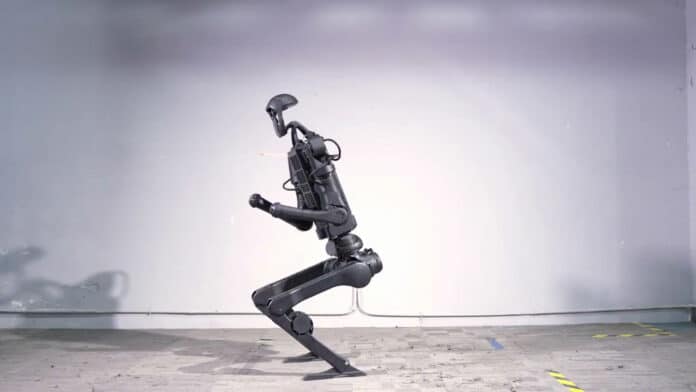Unitree has recently announced its H1 bipedal as the first humanoid robot to execute a standing backflip without the use of hydraulic systems.
Despite other humanoid robots like Boston Dynamics’ Atlas showcasing impressive acrobatic abilities, they were still limited by their reliance on heavy, potentially leaky hydraulics to launch into the air.
Unitree’s H1 robot utilizes in-house M107 electric joint motors, which are incredibly powerful with 360 Nm (265.5 lb. ft) of peak torque. These same motors can also be found on the company’s B2 quadruped.
Recently, the H1 made headlines for setting a Guinness World Record as the fastest full-sized humanoid robot. It achieved a linear walking speed of 7.38 mph (3.3m/s) on a flat surface, surpassing the previous record set by Boston Dynamics’ Atlas.
Without the bulk of hydraulic systems, the H1’s legs have three degrees of freedom at the hip, one at the knee, and one at the ankle. All cabling is routed internally for a sleek and snag-free appearance.
Unitree leveraged reinforcement learning simulation to train their H1 robot in the art of in-place flipping. Despite a minor corrective adjustment towards the end, the execution was graceful.
Although a backflipping humanoid robot may seem like a fascinating spectacle, it’s crucial for it to have practical applications and be more than just a gimmick. The H1’s skill set includes speed-walking, stair climbing, standing jumps, and even dancing, making it a versatile and useful robot.
The Unitree H1 seems to be a promising robot with a lot of capabilities, but its estimated price of $90,000 may make commercialization challenging. Despite this, the H1 is expected to revolutionize industries with its remarkable abilities.
The robot stands 1.8 meters tall, weighs 47 kg (104 lb), and can carry up to 30 kg (66 lb) of payload, striking a balance between size, agility, and payload capacity. Equipped with a replaceable 864-Wh battery and state-of-the-art head-mounted sensors, such as a 3D LiDAR and Intel RealSense depth camera, the H1 is designed to easily navigate complex environments.
Unitree plans to further enhance the H1, including integrating human-like hands. With the world speed record of 3.3 meters per second (7.4 mph), it’ll be interesting to see how fast the commercial unit can go for general use.
